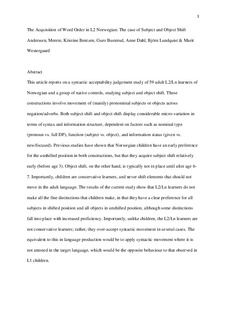The acquisition of word order in L2 Norwegian: The case of subject and object shift
Anderssen, Merete; Bentzen, Kristine; Busterud, Guro; Dahl, Anne; Lundquist, Bjørn; Westergaard, Marit
Abstract
This article reports on a syntactic acceptability judgement study of 59 adult L2/Ln learners of Norwegian and a group of native controls, studying subject and object shift. These constructions involve movement of (mainly) pronominal subjects or objects across negation/adverbs. Both subject shift and object shift display considerable micro-variation in terms of syntax and information structure, dependent on factors such as nominal type (pronoun vs. full DP), function (subject vs. object), and information status (given vs. new/focused). Previous studies have shown that Norwegian children have an early preference for the unshifted position in both constructions, but that they acquire subject shift relatively early (before age 3). Object shift, on the other hand, is typically not in place until after age 6–7. Importantly, children are conservative learners, and never shift elements that should not move in the adult language. The results of the current study show that L2/Ln learners do not make all the fine distinctions that children make, in that they have a clear preference for all subjects in shifted position and all objects in unshifted position, although some distinctions fall into place with increased proficiency. Importantly, unlike children, the L2/Ln learners are not conservative learners; rather, they over-accept syntactic movement in several cases. The equivalent to this in language production would be to apply syntactic movement where it is not attested in the target language, which would be the opposite behaviour to that observed in L1 children.
